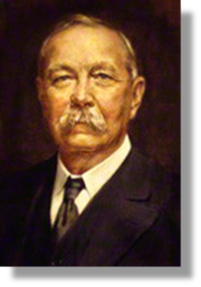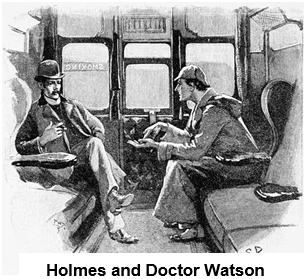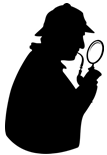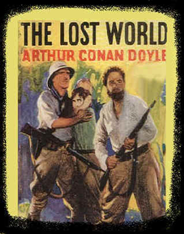


xxxxxThe Scottish
novelist Arthur Conan Doyle trained as a doctor but, inspired by
the works of a number of adventure writers, especially those of
Sir Walter Scott, Edgar Allan Poe, and Robert Louis Stevenson, he
quickly gained fame as a story teller. His well known creation,
the famous detective Sherlock Holmes, along with his good-
ARTHUR CONAN DOYLE 1859 -
Acknowledgements
Conan-
 xxxxxArthur Conan Doyle, the creator of the world famous
sleuth Sherlock Holmes and his worthy assistant Doctor Watson, was
born in Edinburgh and educated in the city’s university. He
qualified as a physician in 1881 and after a short spell as a
ship’s doctor, visiting the Arctic and West Africa, he set up a
practice in Southsea, then a suburb of Portsmouth. Fortunately for
him, as it so happened, he had very few patients, and over the
next eight years he had plenty of time to turn his hand to
writing. Inspired especially by the works of Sir Walter Scott,
Edgar Allan Poe, and Robert Louis Stevenson, it was the start of a
career which was to produce a vast number of works, including
stories of mystery, historical novels, science fiction, poetry and
a deal of non fiction. He was knighted in 1902.
xxxxxArthur Conan Doyle, the creator of the world famous
sleuth Sherlock Holmes and his worthy assistant Doctor Watson, was
born in Edinburgh and educated in the city’s university. He
qualified as a physician in 1881 and after a short spell as a
ship’s doctor, visiting the Arctic and West Africa, he set up a
practice in Southsea, then a suburb of Portsmouth. Fortunately for
him, as it so happened, he had very few patients, and over the
next eight years he had plenty of time to turn his hand to
writing. Inspired especially by the works of Sir Walter Scott,
Edgar Allan Poe, and Robert Louis Stevenson, it was the start of a
career which was to produce a vast number of works, including
stories of mystery, historical novels, science fiction, poetry and
a deal of non fiction. He was knighted in 1902.
xxxxxIt was in 1887 that he published A Study in Scarlet, a mystery novel which introduced the famous Sherlock Holmes and his good natured but bumbling assistant Dr. Watson. From then on both appeared in a number of subsequent detective stories, including The Sign of Four in 1890 and The Final Problem three years later. The character Sherlock Holmes was partly modelled on his former lecturer at Edinburgh Infirmary, the surgeon and criminal psychologist Dr Joseph Bell, a man noted for his powers of deduction and observation. The resemblance was noticed by a number of his friends and acquaintances. Robert Louis Stevenson, for example, writing from his home in the South Seas, noted the similarity between Holmes and his “old friend Joe Bell”.
 xxxxxIn 1890 Conan Doyle spent a year in Vienna taking a
course in ophthalmology, the study of medical and surgical eye
problems. On his return he set himself up as an ophthalmologist in
London but, once again, he met with little success. Indeed, in his
biography he later confessed that not a single patient came to
call! He again turned to writing and in 1891, being anxious to put
his mind to historical novels, he decided to kill off Sherlock
Holmes. In his novel The Final Problem,
published in 1893, he had his popular detective hero and his arch
enemy Professor Moriarty plunge to their deaths in the Reichenbach
Falls in Switzerland, but such was the public outcry that followed
that he was obliged to bring him back from the dead! After taking
part in the Second Anglo-
xxxxxIn 1890 Conan Doyle spent a year in Vienna taking a
course in ophthalmology, the study of medical and surgical eye
problems. On his return he set himself up as an ophthalmologist in
London but, once again, he met with little success. Indeed, in his
biography he later confessed that not a single patient came to
call! He again turned to writing and in 1891, being anxious to put
his mind to historical novels, he decided to kill off Sherlock
Holmes. In his novel The Final Problem,
published in 1893, he had his popular detective hero and his arch
enemy Professor Moriarty plunge to their deaths in the Reichenbach
Falls in Switzerland, but such was the public outcry that followed
that he was obliged to bring him back from the dead! After taking
part in the Second Anglo-

 xxxxxOther novels included his historical romance The
White Company, a boxing story entitled Rodney
Stone, The Exploits and Adventures of
Brigadier Gerard, a set of amusing stories, and The
Lost World, a fantasy adventure which introduced a new
character, the truculent Professor Challenger.
This dominating figure later featured in
other science fiction stories, including The
Poison Belt and The Land of Mist.
His Tales of Terror and Mystery were
published in 1923. His poems, which included Songs
of Action and Songs of the Road,
appeared in 1922, and prime among his non-
xxxxxOther novels included his historical romance The
White Company, a boxing story entitled Rodney
Stone, The Exploits and Adventures of
Brigadier Gerard, a set of amusing stories, and The
Lost World, a fantasy adventure which introduced a new
character, the truculent Professor Challenger.
This dominating figure later featured in
other science fiction stories, including The
Poison Belt and The Land of Mist.
His Tales of Terror and Mystery were
published in 1923. His poems, which included Songs
of Action and Songs of the Road,
appeared in 1922, and prime among his non-
Vc-
xxxxxConan Doyle
took an active part in the affairs of his day. As we have seen, he
was deeply involved in the campaign for the reform of the Congo
Free State -
xxxxxIncidentally, Conan Doyle was given the Christian names of Arthur Ignatius Conan, but for some unknown reason the third name became linked with his surname, and, as a writer, he became known the world over as Conan Doyle. He married Louise Hawkins in 1885 and, following his wife’s death in 1906, he married Jean Leckie. He fathered five children, a girl and a boy with his first wife, and two boys and a girl with his second. ……

xxxxx…… Conan Doyle was a keen sportsman. While working in Southsea he played golf and kept goal for the local football team. And from 1899 to 1907 he occasionally played cricket for the Marylebone Cricket Club. As a bowler he only managed to take one first class wicket, but consoled himself with the fact that it was the wicket of the famous cricketer W.G. Grace! ……

xxxxx……xHis book The
Coming of the Fairies, published in1921, was in response
to the so-
xxxxx……xSherlock Holmes, the world famous detective who lived in Baker Street, London, and was noted for his logical reasoning, is particularly remembered for the phrase “Elementary my dear Watson”. In fact this saying does not appear in any of Conan Doyle’s stories. It was first used at the end of the 1929 film entitled The Return of Sherlock Holmes. ……
xxxxx…… Itxwas the English
illustrator Sidney Paget
(1860-



